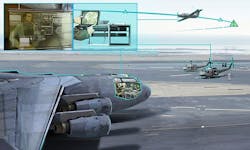Sikorsky to perfect cockpit automation kits for fixed-wing aircraft and helicopters
In fact, researchers are getting close to developing drop-in flight automation systems that could eliminate the need for co-pilots for at least 80 percent of the U.S. military's multi-crew aircraft types.
Officials of the U.S. Defense Advanced Research Projects Agency (DARPA) in Arlington, Va., in late December announced a $35.7 order to Sikorsky, a Lockheed Martin company in Stratford, Conn., for the third and final phase of the DARPA Aircrew Labor In-Cockpit Automation System (ALIAS) program.
The goal of the ALIAS program is to create an easily installable and removable kit that is extensible across the majority U.S. military aircraft and some commercial aircraft, which automates co-piloting functions to enable reduced crew operations.
ALIAS seeks to develop automation-augmented avionics for piloted military aircraft to enhance system performance beyond human precision or capacity alone, reduce costs by reducing the number of crew necessary to operate multi-crew fixed-wing aircraft and helicopters, and enable new missions and capabilities, especially with reduced human exposure to dangerous or life-threatening situations.
In addition, ALIAS seeks to automation technology applicable to a broad variety of military aircraft, rather that use aircraft-specific pilot controls and interfaces to automate flight tasks.
By divorcing the operator interface from legacy hardware, the ALIAS program seeks to reduce the costs of training aircraft pilots. The program also seeks to develop aircraft-agnostic automation packages applicable to many different aircraft by using a partitioned model that enables aircraft designers to introduce new software or algorithms incrementally introduced without causing major problems for host aircraft.
In the second phase of the ALIAS program, Sikorsky installed and demonstrated ALIAS automation technology aboard two different Cessna 208 Caravan fixed-wing aircraft, a Diamond DA-42 fixed-wing aircraft, and a Sikorsky S-76 helicopter.
Ground demonstrations showed how ALIAS can respond to various simulated flight emergencies like system failures, demonstrated quickly tailoring ALIAS to new aircraft, and showing that installation and removal of the kit does not affect airworthiness.
In ALIAS phase three, Sikorsky will focus on building and installing prototype ALIAS kits on several different kinds of aircraft types for flight demonstrations. The first and second phases of the ALIAS program also involved Aurora Flight Sciences Corp. in Manassas, Va.
story continues below
In the first phase of the ALIAS program, Sikorsky and partners Sikorsky Innovations -- the rapid prototyping arm of Sikorsky Aircraft -- as well as the United Technologies Research Center, the National Robotics Engineering Center, and Veloxiti Inc. applied autonomous technology across different aircraft, including the UH-60 Black Hawk helicopter and other military aircraft.
In launching its original autonomy program in 2013, Sikorsky outfitted an S-76 commercial helicopter with fly-by-wire controls and the Matrix Technology suite, creating the Sikorsky Autonomy Research Aircraft (SARA) as its flying test lab.
SARA is enabling rapid flight testing of software and hardware, including multispectral sensors previously integrated in Sikorsky systems integration labs.
Related: The critical value of human intelligence in the cockpit
In 2014 Sikorsky experts worked together with the U.S. Army to complete the Manned Unmanned Resupply Aerial Lifter (MURAL) program that modified a Black Hawk helicopter for autonomous and remotely supervised control.
On the ALIAS phase 3 project, Sikorsky will do the work in Stratford, Conn.; Westford, Mass.; Pittsburgh; Orlando, Fla.; Canton, Conn.; and East Hartford, Conn., and should be finished by February 2018.
For more information contact Sikorsky, a Lockheed Martin company, online at www.lockheedmartin.com, or DARPA at www.darpa.mil.
Learn more: search the Aerospace & Defense Buyer's Guide for companies, new products, press releases, and videos
